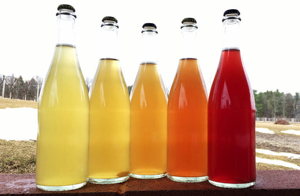This week – July 20-26, 2020 – we are celebrating the 3rd annual National Prosecco Week! So pop a cork on your favorite bottle of Prosecco, pour yourself a glass of that cold, refreshing, crisp bubbly, and read on to learn all about this super popular sparkling wine.
What is Prosecco?
Prosecco is Italy’s most popular sparkling wine, made from the Glera grape in the northeastern part of the country. It is produced in a large area covering the Veneto and Friuli Venezia Giulia regions, and is named after the village of Prosecco.
What does Prosecco taste like?
Prosecco is a dry style sparkling wine that is light bodied, fresh and crisp with fruity flavors of green apple, honeydew melon, pear, and honeysuckle. Prosecco bubbles measure in at approximately 3 atmospheres of pressure, while Champagne in comparison has stronger bubbles at approximately 6 atmospheres.
Although it is fruity, Prosecco is not sweet. It contains only small amounts of residual sugar to balance out the high acidity, but this sugar is generally not detectable on the palate. The levels of sweetness in these wines are labeled as follows:
- Brut: 0-12 grams of residual sugar per litre.
- Extra-Dry: 12-17 grams of residual sugar per litre.
- Dry: 17-32 grams of residual sugar per litre.
How is Prosecco made?
Prosecco is made using the Charmat, or Tank, method. This is a different manner of producing sparkling wine from the Traditional method, which is used to make Champagne.
The Charmat method was invented in 1895 and enabled large volumes of sparkling wine to be made inexpensively and quickly, so they could be released for sale faster. By comparison, the Traditional method is longer, more labor intensive, imparts deeper flavors of yeast and bread into the finished wine, and results in a more complex, yet more expensive bottle of wine.
Prosecco’s Charmat method is an expedited production process ideal for fruity wines. These wines are produced using the following steps:
- Fruit for sparkling wine is often harvested early while the grapes contain higher levels of acidity and lower levels of sugar. The fruit must be in perfect, healthy condition when picked, as any bad flavors from rotten fruit will be enhanced by effervescence. Therefore, the grapes are usually hand harvested and sorted.
- The grapes are gently pressed to extract clean juice while minimizing skin contact to avoid bitter tannins (tannins are contained in grape skins).
- The juice is fermented in stainless steel tanks by adding yeast, which converts sugars into alcohol. This creates a base dry white wine. Since the grapes are picked early with low levels of sugar, the resulting base wine has a low level of alcohol.
- The base wine is then transferred to autoclaves, which are sealed and pressurized tanks. A mixture of sugar and yeast is added to trigger a second alcoholic fermentation. The CO2 produced during this stage of fermentation is trapped in the wine because the tanks are sealed, resulting in bubbles! This secondary fermentation also increases the level of the alcohol in the final wine.
- The wine is then brought to the desired sweetness level either by adding “dosage” (a sugar and wine mixture), or by stopping fermentation by cooling the wine when the desired pressure and sugar level is achieved.
- Occasionally, higher quality and more expensive Prosecco’s will be aged for several months before release, but the majority of wines are bottled immediately and sent off to the marketplace!
How do I choose the highest quality Prosecco?
Italy has wine laws that designate a quality hierarchy as follows:
- Vino de Tavola (VDT) – simple table wines
- Indicazione Geographica Tipica (IGT) – Upgraded table wines with higher quality standards.
- Denominazione di Origine Controllata (DOC) – indicates superior quality wines in Italy.
- Denominazione di Origine Controllata e Guarantita (DOCG) – identifies Italy’s highest quality wines, and the most stringent rules apply. These wines must pass an in-depth laboratory analysis and tasting panel to guarantee their merit.
Most of the growing region for Prosecco is a DOC zone. However, within the larger Prosecco geographical area is a smaller, more prestigious DOCG area called Conegliano Valdobbiadene Prosecco in the hills between the towns of Conegliano and Valdobbiadene.
This area produces the most elegant expressions of Prosecco due to its steep hillsides, stony soils, and cooling breezes from the Adriatic Sea, all creating a moderate climate with ideal growing conditions. These Prosecco Superior DOCG wines must follow stricter rules including lower grape yields, hand harvesting, higher minimum alcohol levels, and vintage dating.
To find these wines, look for “Valdobbiadene Prosecco” or “Prosecco Superior DOCG” on the label, along with a DOCG sticker usually placed around the neck of the bottle.
How popular is Prosecco?
Prosecco is the best-selling sparkling wine in the world by volume, taking away from the market share of Champagne in recent years. Prosecco’s success is attributed to its lower price, its greater approachability of fruity flavor, and its profile as a sparkling wine that can be drunk anytime, and not just for special occasions. With an average production cost of $4.20 per bottle, a fraction of Champagne’s average $11.63, Prosecco can be purchased at a price that makes it easier to buy for more casual settings.







